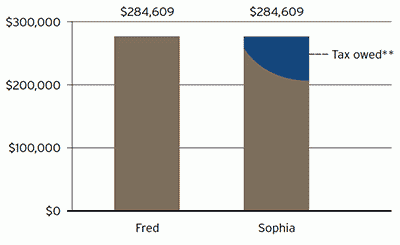
The Faculty and Staff Retirement Plan allows you to contribute on a Roth after tax basis.
Through the Roth 403(b) option you can make contributions that are taxed based on your current tax rates, so you can make tax-free withdrawals later in retirement after meeting certain criteria. This option may benefit you if you expect your tax rate to be the same or higher in retirement.
The Roth 403(b) is different from a Roth IRA and is not subject to the same income limits. The Roth 403(b) is part of the Duke Faculty and Staff Retirement Plan, and allows you to contribute on an after-tax basis. Your combined pre-tax and Roth after-tax contributions are subject to the same annual IRS-established maximum limit.
Meet with your tax advisor or a Fidelity financial representative to discuss whether the Roth 403(b) is right for you.
Roth contributions will change your take-home pay
Because Roth 403(b) contributions are under the same IRS limits as pre-tax contributions to the Faculty and Staff Retirement Plan, each dollar of a Roth contribution reduces the amount that can be contributed pre-tax and vice versa.
Your take-home pay will be less than it would be if you made an equivalent pre-tax contribution because income taxes must be withheld and paid on after-tax Roth 403(b) contributions.
How to Enroll for Roth 403(b) Contributions
Signing up for Roth contributions is easy. Click here for more information.
Example

Example: Sophia and Fred each contribute $3,600 a year to the 403(b) Plan, and both earn 6% annually on their investments. But Sophia makes pre-tax contributions while Fred makes Roth contributions. (That means Fred's contributions are taxed as regular income before being added to his account.) After 30 years each has $284,609 for retirement. However, Sophia will owe taxes on her withdrawals. Fred's withdrawals will be tax-free.*
This hypothetical illustration does not represent any particular investment.
* Fred paid $16,200 in taxes on contributions over 30 years, assuming a 15% tax bracket. All tax references apply to federal taxes only. Individual state tax laws may vary.
** The amount of taxes owed will depend on the tax rate at the time of the distribution and the amount withdrawn.
Roth 403(b) Questions and Answers
What is the Roth 403(b)?
The Roth 403(b) is part of the Duke Faculty and Staff Retirement Plan, and allows you to contribute on an after-tax basis. Your combined pre-tax and Roth after-tax contributions are subject to the same annual IRS-established maximum limit.
You get no current-year tax deduction for your Roth contributions. However, you can withdraw your contributions and their earnings tax-free later if you meet certain conditions.
Are Roth IRAs and Roth 403(b)s the same?
No, there are some differences:
- The Roth 403(b) does not have an income restriction, but a Roth IRA does restrict participation based on income level.
- With the Roth 403(b) you will be able to contribute up to the 403(b) IRS limit. The limit reflects your total 403(b) contributions, whether pre-tax, Roth after-tax, or a combination.
You may be able to contribute to both the Roth 403(b) and a Roth IRA. Check with your tax advisor for more information.
What are the conditions for tax-free withdrawals?
In general, to make a qualified tax- and penalty-free withdrawal of Roth contributions and earnings, the following conditions must be met:
- the account must have been established for at least five years, and
- the withdrawal must be taken at or after age 59 1/2, or as the result of disability or death.
Distributions that don't meet these conditions are considered nonqualified and may be subject to taxes and penalties.
When does the five-year period begin?
It begins on January 1 of the year you make your first Roth contribution, which can be made at any time during the year. Even if you contribute in December, you will still receive a year's credit. Also, you don't have to make a contribution every year. Your first contribution "starts the clock."
What if a withdrawal doesn't meet these conditions?
Withdrawals that do not meet these conditions are considered nonqualified withdrawals. Nonqualified withdrawals are treated as a prorated return of Roth contributions and earnings. The portion of the distribution that represents earnings will be subject to ordinary income tax and possibly a 10% federal penalty tax for early distributions. However, the portion of the withdrawal that represents a return of Roth contributions would not be subject to tax.
Can I convert my pre-tax 403(b) balance to Roth after-tax?
This feature is not currently available.
Do I have to take required minimum distributions (RMDs) from my Roth 403(b)?
No, SECURE 2.0 eliminates required minimum distributions for Roth accounts in employer plans, effective for taxable years beginning after December 31, 2023. For questions about how this legislative change might impact your retirement planning, please consult with your tax advisor or financial planner.